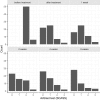Efficacy of desensitizing products containing 8% arginine and calcium carbonate for hypersensitivity relief in MIH-affected molars: an 8-week clinical study
- PMID: 28004247
- PMCID: PMC5559563
- DOI: 10.1007/s00784-016-2024-8
Efficacy of desensitizing products containing 8% arginine and calcium carbonate for hypersensitivity relief in MIH-affected molars: an 8-week clinical study
Abstract
Objectives: The objective of this study was to compare the efficacy in reducing hypersensitivity in molar incisor hypomineralization (MIH)-affected molars immediately and over 8 weeks combining a single in-office application and a homed-based program with desensitizing products containing 8% arginine and calcium carbonate.
Materials and methods: Nineteen children with at least one MIH-affected molar with hypersensitivity were included. Hypersensitivity was assessed with an evaporative (air) stimulus and a tactile stimulus. Each child received a single in-office treatment with a desensitizing paste containing 8% arginine and calcium carbonate (elmex Sensitive Professional desensitizing paste), followed by 8 weeks of brushing twice daily with a desensitizing toothpaste containing 8% arginine, calcium carbonate with 1450 ppm fluoride (elmex Sensitive Professional toothpaste), using the elmex Sensitive Professional toothbrush. Additionally, the corresponding mouthwash (elmex Sensitive Professional mouthwash) was used. Clinical assessments were made at baseline, immediately after the in-office treatment and after 1, 2, 4 and 8 weeks of brushing twice daily.
Results: Fifty-six molars with an air blast hypersensitivity score of 2 or 3 (Schiff Cold Air Sensitivity Scale) were included. Application of the desensitizing paste decreased hypersensitivity significantly immediately and throughout the 8 weeks recalls (p < 0.001).
Conclusions: In conclusion, 8% arginine and calcium carbonate were able to reduce hypersensitivity successfully during this 8-week trial.
Clinical relevance: Hypersensitivity is a major complaint in patients with MIH. This is the first study evaluating the desensitizing effect of a desensitizing paste containing 8% arginine and calcium carbonate in patients with MIH.
Keywords: Arginine; Children; Desensitizing; Hypersensitivity; Molar incisor hypomineralization (MIH).
Conflict of interest statement
Conflict of interest
The authors declare that they have no conflict of interest.
Funding source
The work was supported by CP Gaba GmbH, Germany.
Ethical approval
All procedures performed in studies involving human participants were in accordance with the ethical standards of the institutional and/or national research committee and with the 1964 Helsinki declaration and its later amendments or comparable ethical standards. Approval for this clinical investigation was obtained from the ethics committee of the local University Review Board (Martin-Luther-University Halle-Wittenberg; approval 2014–34).
Informed consent
Informed consent was obtained from all individual participants included in the study.
Figures
References
-
- Mast P, Rodrigueztapia MT, Daeniker L, Krejci I. Understanding MIH: definition, epidemiology, differential diagnosis and new treatment guidelines. Eur J Paediatr Dent. 2013;14:204–208. - PubMed
Publication types
MeSH terms
Substances
LinkOut - more resources
Full Text Sources
Other Literature Sources
Research Materials


